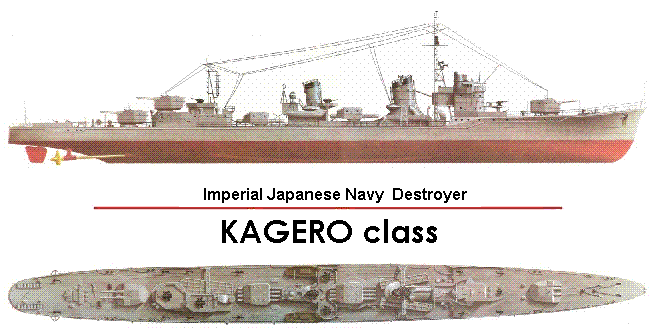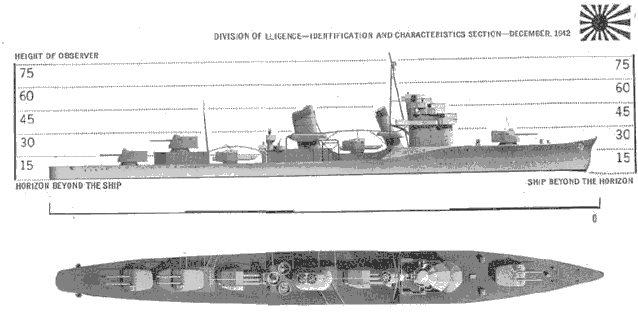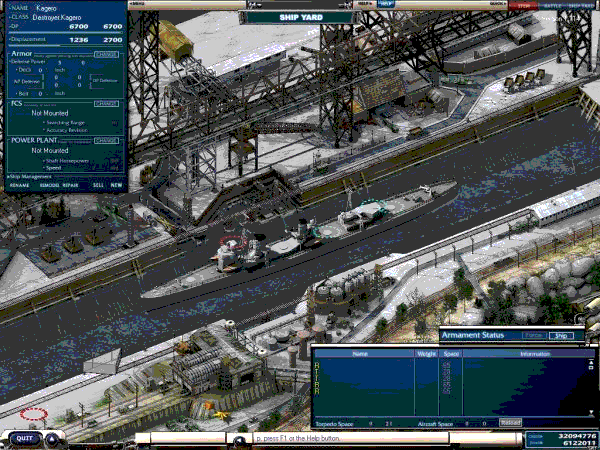
Imperial Japanese Navy - KAGERO class Destroyer ==========================================================================

The Kagerô was the lead ship of her class of destroyer in the Imperial Japanese Navy. Her name means "Gossamer Haze", "Glimmering Spring Air", "The Shimmering Mist that Rises from the Earth on a Hot Day", or "Heat Shimmer".
The Kagerô class destroyers were a class of ships in service with the Imperial Japanese Navy during World War II. They were armed with six 5 in (127 mm)/50 cal. guns and eight 24 inch (610 mm) torpedo tubes for the "Long Lance" torpedo. At the time of completion, these destroyers were as good as or better than similar ships in other navies. Only the lack of radar would hinder their otherwise superb design. As with most pre-World War II ships, Kagerôs were also deficient in anti-submarine and anti-aircraft weaponry. Over the course of the war these would be remedied, with depth charge capacity increased to 36 and the addition of four depth charge launchers; anti-aircraft weaponry also increased steadily from only four 25 mm machine guns at the start of the war to 28 by the end.
The Kageros were completed in 1939-41 and took full advantage of the lapse of the naval treaties. They were very powerful units with excellent firepower, strength, and range, lacking only somewhat in speed.
The Imperial Navy's search for the ideal destroyer found fruition in the KAGERO class. Referred to variously as the "Special Type," "cruiser-type" and, beginning with the KAGEROs, "Type A," this classically- Japanese design combined speed, range, firepower and stability in equal and eminently successful proportions.
The Kagero class destroyers were the largest destroyers built at the time. Their design was based off of the Asashio class coupled with improvements. They were considered the perfect fleet destroyer. The Kagero class was approved of in the 1937 and 1939 Programs and were laid down in the same period. The ships were completed between November, 1939, and June, 1941.
That there were 19 rather than the oft-quoted 18 units in this class, with AKIGUMO representing the nineteenth, will come as a surprise to many. AKIGUMO has always been placed firmly in the following YUGUMO class, and only the most recent publications out of Japan are beginning to buck that trend. This is due primarily to the research and writings of Japanese naval historian Tamura Toshio, who would go further in stating that this has really been more or less common knowledge for many years now.
Those who drafted the Imperial Navy's 1937 and 1939 building programs blurred the dividing lines between them (and between the KAGERO and YUGUMO classes as a result) by adding in five fictitious destroyers, this to help conceal the resource allocations being devoted to the huge battleships of the YAMATO class. The first 15 units of the KAGERO class (hull numbers 17-31) were authorized under the 1937 Program — as were the fictitious numbers 32-34. The last four, designated the ARASHI group (hull numbers 112-115), followed in the 1939 Program -- along with the first 11 YUGUMOs, the SHIMAKAZE, and a couple more counterfeits. Postwar officials, primarily unqualified army and government clerks rather than navy men (though the latter did include the formidable Fukui Shizuo), tried to unscramble and make sense of these plans and the various documents that supported them. In so doing, and probably further mislead simply by her name, they placed No. 115 AKIGUMO on "the wrong side of the ledger," with No. 116 YUGUMO and her sisters.
The KAGEROs benefitted greatly from the many teething troubles of the previous ASASHIO class, and as a result experienced almost none of their own. Virtually identical in appearance to their predecessors, they also mounted the same armament of six 5" guns in Type C turrets, and eight 24" torpedo tubes. Although the KAGEROs were some 72 tons heavier and sported a slightly thicker bridge structure, their stability was improved by lowering the fore quadruple torpedo tube mount and moving its reloads forward abaft the bridge. One unit, the AMATSUKAZE, was fitted with experimental high-pressure boilers, but her performance was not markedly superior to that of her sisters.
Upon completion the KAGEROs were the equal of any of their contemporaries in other navies and superior to most. Only the initial lack of radar and continued poor quality of sonar equipment -- shortcomings which bedeviled all Japanese destroyers -- hindered their performance. These were never completely made good, but early deficiencies in antisubmarine and antiaircraft weaponry soon were. As in many other classes, depth charge stowage was increased to 36 and four throwers were added. Light AA armament also grew steadily, and eventually numbered twenty-eight 25 mm. machine guns following removal of the "X" gun turret from all surviving ships of the class, in late1943-early 1944, in favor of two triple 25mm. mounts. (Those so altered included AKIGUMO — but none of the YUGUMO class!)
Around the end of 1942 HAMAKAZE became the first destroyer in the Japanese Navy to be fitted with radar, shipping a Type 22 set. Her sisters were then likewise equipped as they rotated homeward from the front for refitting.
At the beginning of the Pacific War the KAGEROs formed the backbone of the Empire's first-line destroyer strength, comprising the 4th, 15th, 16th, 17th, and half of the 18th Destroyer Divisions. ("Orphan" AKIGUMO, to even-up numbers -- and further confuse matters! -- was later assigned to the YUGUMO-equipped Desdiv 10.)
The greatest of all the KAGEROs was unquestionably the YUKIKAZE. That fine ship not only survived the war, but did it the hard way, taking part in countless surface, air-sea and antisubmarine actions in the war's toughest theaters, yet always emerging with little or no damage. Equally robust, if less fortunate, were AKIGUMO, NOWAKI and the entire 17th Destroyer Division.
Japan's Southeast Area of the Pacific was hardest on them, six of the class being lost in the Solomons and two off Eastern New Guinea. Most of those that came through this rugged campaign survived into the last year of the war, but only YUKIKAZE was still afloat at its end. Altogether, six were sunk by air attack, five by submarines, five by surface forces and one by mine, with another two succumbing to a combination of mines and aircraft.
The attrition rate of Japanese destroyers was extremely high due to the need to use them for transporting supplies to the many scattered island garrisons. Wartime attrition was hard on the Kagerôs, with 18 out of 19 ships lost. In all, six were sunk by air attack, five by submarine attack, five in battle with other surface forces, one by mine, and the remaining two sunk by a combination of mines and air attack. The Yukikaze was the only Kagerô-class ship afloat at the end of the war.
Yukikaze's last major combat operation, on 7 April 1945, was as part of the force built around the battleship Yamato in a desperate, and intentionally suicidal, attempt to attack U.S. forces off Okinawa.
She was joined in the sortie by her sister ship, the Isokaze. The Isokaze was damaged severly in the raid and the Yukikaze was forced to sink her with her own batteries. Having escaped the air attacks that sank Yamato, Yukikaze returned to Japan. In late July 1945, shortly before the fighting ended, she was damaged by a mine, but was apparently not seriously hurt.
One of the handful of Japan's larger destroyers (out of a hundred) to survive the war in serviceable condition, she was disarmed for use bringing Japanese military personnel and civilians home from that nation's former overseas empire. In July 1947, shortly after this task was completed, Yukikaze was transferred to the Chinese Navy, which renamed her Tan Yang. She accompanied the Nationalist Government to Taiwan after it was driven from the mainland in 1949 and continued in service for two more decades. The old destroyer was scrapped in 1971.
=================================================================================
NB: The above text has been collected / excerpted / edited / mangled / tangled / re-compiled / etc ... from the following online sources :
IJN - KAGERO class Destroyer - wikipedia article #1
IJN - KAGERO class Destroyer - wikipedia article #2
IJN - KAGERO class Destroyer - www.globalsecurity.org
IJN - KAGERO class Destroyer - www.combinedfleet.com



